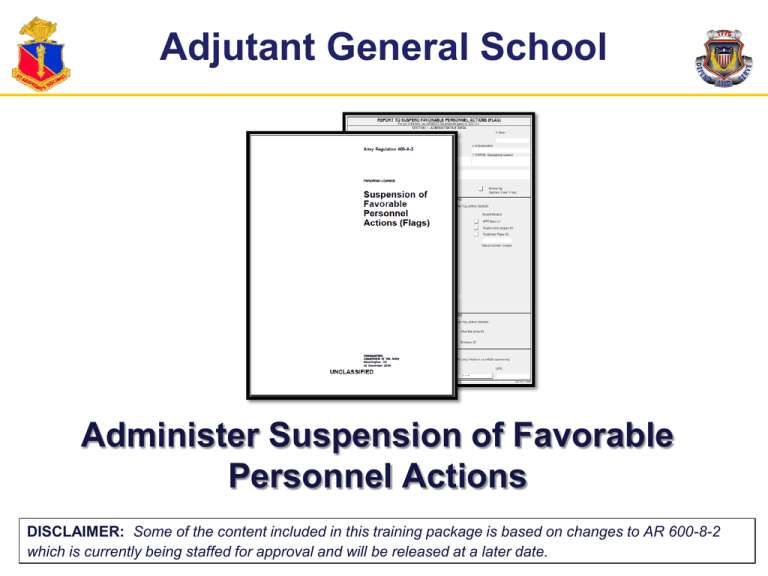effective date of the flag
advertisement

Adjutant General School Administer Suspension of Favorable Personnel Actions DISCLAIMER: Some of the content included in this training package is based on changes to AR 600-8-2 which is currently being staffed for approval and will be released at a later date. Terminal Learning Objective Action: Administer Suspension of Favorable Personnel Actions (FLAG) Conditions: In a classroom environment, given AR 600-8-2, DA Form 268, and awareness of Operational Environment (OE) variables and actors. Standards: The student will have met the standards when they fully understand the processing and procedures for flagging actions listed below: 1. 2. 3. 4. Communicate general policy and impact of flagging actions Determine effective dates of flagging actions Process initiation and removal of flags Manage flagging actions at all levels 2 Purpose of Flag (1 of 2) A Flag is an “administrative tool” used to prevent and/or preclude: Execution of favorable actions Movement of a Soldier A Flag (DA Form 268) will be initiated immediately when a Soldier’s status changes from favorable to unfavorable. Flags are not to be used for punishment or restriction. Flags are not the final disposition. AR 600-8-2, Para 2-1 3 Purpose of Flag (2 of 2) A Flag will not be removed for the purpose of allowing a Soldier to PCS. A Flag is mandatory when an investigation is initiated by military or civilian authorities. Commander establish internal controls: “Need to Know” Health Promotion, Risk Reduction and Suicide Prevention Favorable actions are not granted DA Form 268 is prepared to suspend favorable actions DA Form 268 is prepared to removed flagging action AR 600-8-2, Para 2-1 & 2-2 4 Favorable Actions Impacted by a Flag (1 of 2) Appointment, reappointment, reenlistment, or extension • Unless authorized by AR 601-280, AR 135-180, AR 135-205, or AR 140-111 Reassignment • Additional guidance see paragraph 2-9 Promotion • Appearance before a semi-centralized promotion board • Promotions in grade, lateral appointments, and frocking Awards-Soldier may neither be recommended for nor receive awards • Awards and decorations for valor or heroism may be processed and presented to Soldiers who are flagged for AWCP or APFT failure (WITHOUT A WAIVER) • Overweight or APFT failure may be recommended and presented a posthumous award, decoration, or a badge without a waiver and assigned to a unit engaged in combat against hostile forces and Soldier dies a result of injuries sustained during combat Attendance at military or civilian schools •Waiver approval authority is Army G-3/5/7 AR 600-8-2, Para 3-1 5 Favorable Actions Impacted by a Flag (2 of 2) USAR Soldiers flagged for not complying with the AWCP cannot participate as platform instructors IAW AR 140-1 Unqualified resignation, retirement, or discharge Advance or excess leave, unless granted as an exception to policy by commanders in accordance with AR 600-8-0 Payment of enlistment bonus (EB) or selected reenlistment bonus (SRB) Assumption of command (AR 600-20) Family member travel Command sponsorship of family members AR 600-8-2, Para 3-1 6 Non-Transferable Flags Circumstances that may result in a Soldier requiring a Non-Transferable Flag. The flagged Soldier may not be transferred to another unit (except as provided for in paragraph 2-2). Ensure the correct reason code is being used IAW Table 2-1. Non-Transferable Non-Transferable • Adverse actions (A) • Alcohol abuse adverse action (V) • Involuntary separation/discharge (B) • Commander’s Investigation (L) • Removal from a selection list -Field initiated (C ) • Law enforcement investigation (M) • Pending removal/consideration from a command, promotion, or school selection listHQDA initiated (F) • Non-recommendation for automatic promotion (P) or (T) • Lautenberg Amendment (X) • Referred OER/ Relief- for-Cause NCOER (D) • Family Care Plan (X) • Security violations (E) • Army Medical Department (X) • Drug abuse adverse action (U) • Noncompliance with title 10 USC 10206 (X). 7 AR 600-8-2, Para 2-2 Transferable Flags Circumstances that may result in a Soldier requiring a Transferable Flag. The flagged Soldier may be transferred to another unit IAW Paragraph 2-3. Ensure the correct reason code is being used IAW Table 2-1. Punishment phase (H) • When actions resulting from a court-martial, non-judicial punishment, or punishment from a civil court have moved into the punishment phase and punishment does not include confinement, restraint, or geographical travel restrictions imposed by civilian courts as a condition of parole, probation, or suspended sentence Army Physical Fitness Test (APFT) (J) •Soldier fails a record APFT •Soldier fails to take the APFT within prescribed by regulation or when directed by commanding officer •Soldier who become pregnant after being flagged for failing an APFT, will remain flagged until successfully passing an APFT •Soldiers with a profile effective after the APFT will remain flagged until a record APFT is passed •A flag is not required for a Soldier who has a permanent or temporary profile that precludes taking the APFT or is unable to undergo an APFT because of conditions beyond the Soldier’s control (as determined by the commander). Army Weight Control Program (AWCP) (K) • Soldier was found to be in noncompliance with AR 600-9 • The use of certain medication to treat an underlying medical disorder or the inability to perform all aerobic events may contribute to weight gain but are not considered sufficient justification for noncompliance with AR 600-9 and Soldier will be flagged. • If a pregnant Soldier flag was initiated before pregnancy (as determined by a physician) the flag will remain in effect until the Soldier complies with AR 600-9. AR 600-8-2, Para 2-3 8 Check on Learning 1. Q. CPT Myers just returned from three weeks of leave in Hawaii and therefore, was not able to take his APFT. The commander directed CPT Myers to take his APFT no later than Wednesday of the following week. CPT Myers failed to take his AFPT. What action should you take as the commander? A. Initiate a Flag (Para 2-3d) 2. Q. SSG Brown is assigned to Co A, 1st Bn, 316th AR and is pending removal from the SFC list. There is a need for a qualified Battle Staff Operation NCO in one of the other battalion’s within the same Brigade. Can the brigade Commander direct SSG Brown be reassign with a pending flagging action? A. Yes (Para 2-2) 3. Q. SPC Austin was enrolled in the AWCP and recently found out that she is pregnant. What action should you take as the commander? A. No action is required, the flag will remain in effect until the soldier complies with AR 6009 (Para 2-3e) 4. Q. SGT Harrison received his second DUI and was flagged pending administrative action. SGT Harrison’s commander recommended separation and his packet was submitted to the administrative separation board. The board recommended that the Soldier be retained. Can the commander remove the flag? A. No, the flag may only be removed by the General Court-Martial Convening Authority. (Para 2-9b (2) Effective Dates (1 of 2) The effective date of a flag, unless otherwise specified in this regulation, will be the date that the circumstance(s) requiring the flag occurred, not the date the flag was initiated (e.g. if the circumstance occurred on the 25th of March, but the flag was not initiated until the 3d of April, the effective date of the flag would still be the 25th of March). Soldier is pending a non-punitive memorandum of reprimand, censure, or admonishment. Flag will be effective on the day the offense (leading to the memorandum) took place. Soldier is absent without leave (AWOL), submit the initial flag on the second day of AWOL, with an effective date of the first day of AWOL. The effective date of the flag will be the date the commander signs the intent to separate notification memorandum to the Soldier or the date HQDA initiates an involuntary separation action. A flag is initiated based on the adverse action resulting from the alcohol or drug abuse-related incident. A flag may NOT be initiated based on referral, screening or enrollment into the Army Substance Abuse Program (ASAP). Effective date of the flag is the date of offense, the date the commander directs the investigation, the date the commander appoints an investigation officer, or the date the investigating officer suspects the Soldiers may be subject to disciplinary action. AR 600-8-2, Chap 2, Para 2-2 & 2-4 10 Effective Dates (2 of 2) The effective date of the flag will be the through date listed on the OER or NCOER, the date the decision was made to administer the referred OER, or the date of relief. Effective date of the flag is the date of offense or the date law enforcement identifies or titles the Soldier as a subject or suspect. A Soldier denied automatic promotion to PV2 thru SPC, they must flag the Soldier no later than the 20th day of the month preceding the month of automatic promotion in accordance with AR 600-8-19. An officer denied automatic promotion to CW2 or 1LT, they must flag the officer. To ensure promotion orders are not erroneously cut, the flag must be input into HR systems no later than 90 days prior to the month of automatic promotion. Lautenberg Amendment. Soldiers with a qualifying conviction under the Domestic Violence Amendment to the Gun Control Act of 1968 must be flagged as required by AR 600-20. Soldiers who fail to provide and maintain an adequate Family care plan, as required by AR 600-20 must be flagged. Effective date of the flag will be the suspense date established by the commander for completion and approval of DA Form 5305 with attendant documents in accordance with AR 600-20 AR 600-8-2, Chap 2, Para 2-2 & 2-4 11 Initiating a Flag 1 A Flag, DA Form 268 (Suspension of Favorable Personnel Actions) and HR system input, will be initiated immediately when a Soldier’s status changes from favorable to unfavorable. A separate flag will be CDR directs Flag initiated for each reason for flagging a Soldier listed in this regulation 2 3 DA Form 268 prepared / authenticated S-1 inputs flag into HR system TAPDB * reflects flag 6 7 Unit Cdr/1st Line Supervisor Counsels Soldier 4 5 Unless otherwise specified in this regulation, only commanding officers, commandants, or an officer with specific authority to sign “For the Commander” (e.g. battalion or higher XO, Deputy Commander, or Adjutant) may authenticate a DA Form 268. The Commander, AHRC (AHRC-PDV-P) will authenticate adverse action flags or investigation flags initiated by HQDA Record File created Soldiers not on active duty will be counseled regarding initiation of a flag prior to the conclusion of the first training period following the date the Flag was initiated. Coord. w/ Security & Retention NCO ID impacts on favorable actions The flagging authority, unit commander or first line supervisor will counsel all Soldiers on active duty in writing upon initiation of any flag within two working days. Counseling should include reason for the flag, requirements for flag removal, and actions prohibited by the flag. All Soldiers will be provided a copy of the DA Form 268 initiating and removing a flag Unit S-1 Units will maintain DA Form 268s and supporting documentation on active flags for all Soldiers within their unit. AR 600-8-2, Para 2-7 Removal Dates (Non-Transferable/Transferable) (1 of 3) • Charges, restraint, confinement, court-martial, nonjudicial punishment and AWOLremove the flag when the Soldier is acquitted at court-martial or civilian trail and no other adverse action adverse action arising from the incident or charges is contemplated. (see para 2-9 a. (1) for additional dates) • Administrative reduction- remove the flag on the date of reduction • Memorandum of admonishment, censure, or reprimand not administered as nonjudicial punishment- Remove the Flag on the date the appropriate authority directs the filing of the signed memorandum (AR 600–37) or on the date the memorandum is rescinded without filing. • Commander’s Investigation-remove the flag when investigation results in no adverse findings against the Soldier (see para 2-9 a. (9) for additional dates) • Law enforcement investigation- remove the flag when the completed DA Form 4833, Commander’s Report of Disciplinary or Administrative Action, is submitted to the provost martial or USACIDC in accordance with AR 190–45. AR 600-8-2, Para 2-9 13 Removal Dates (Non-Transferable/Transferable) (2 of 3) • Referred officer evaluation report or Relief-for-Cause noncommissioned officer evaluation report - remove the flag when the evaluation is accepted error-free by AHRC or State MILPO and uploaded to the Soldier’s Army Military Human Resource Record (AMHRR). • For first time drug offenses - remove the flag when Soldier is reassigned to the transition point for separation or, if separation authority retains the Soldier, remove the flag when punishment is complete. • For second-time or higher drug offenses - remove the flag when Soldier is reassigned to the transition point for separation. If a show-cause board, administrative separation board, or separation authority retains the Soldier, the flag must be removed by the General CourtMartial Convening Authority. • Involuntary separation or discharge-remove the flag when Soldier is reassigned to a transition point or retained. • Alcohol abuse adverse action- remove the flag when the punishment is complete. • Promotion to PV2 thru SPC- remove the flag no later than two working days following the 14 date the Soldier would have been automatically promoted. AR 600-8-2, Chap 2, Para 2-2 & 2-3 Removal Dates (Non-Transferable/Transferable) (3 of 3) • Promotion to 1LT - remove the flag when the officer is reassigned to the transition point or, if the denial for promotion to 1LT is held in abeyance for up to 6 months, remove the flag when the commander elects to promote the officer. • Lautenberg Amendment- remove the flag when conviction is expunged, pardoned or set aside by competent authority or when Soldier is transferred to transition point for separation. • Family care plan- remove the flag when the Family Care Plan is approved or recertified by the commander. • Punishment phase- remove flag upon completion of punishment. • Army Physical Fitness Test (Failure)-remove flag on date of compliance • Army Weight Control Program (Non-compliance) -remove the flag (code E) on date of compliance. AR 600-8-2, Chap 2, Para 2-2 & 2-3 15 Report codes AR 600-8-2, Table 2-2 16 Removal of a Flag Step 1 Cdr directs flag removal Step 3 S-1 removes flag from HR system/*TAPDB Step 2 Unit/S-1 DA Form 268 prepared authenticated Promotable? No A flag will be removed as soon as practical after the Soldier’s status changes from unfavorable to favorable. Unit S-1s will maintain all DA Form 268s with supporting documentation on all closed flags for 1 year. Yes • Step3a • Forward 268 to HRC without submitting transaction in HR system S-1 Step 7 Maintain closed flags for 1 year Step 5 Unit/S-1 ID impacts on favorable actions Step 6 Unit Counsels Soldier •Step 4a • Is Promotion reconsideration warranted? NO Yes Step 4 Unit/S-1 Coordinate w/Security & Retention NCO HRC • Step 5a • Flag removed from system by HRC and Promo orders cut on Promotion Eligibility Date HRC Step 6a If promotion reconsideration is warranted, HRC will initiate a HQDA flag for ‘Removal from a selection list’ and initiate a Promotion Review Board (PRB) or Standby Advisory Board (STAB) for promotion reconsideration. HRC will then authorized the unit to lift the locally initiated flag from the HR system AR 600-8-2, Para 2-9 17 Check on Learning 1. Q. PV2 Bishop is scheduled to be automatically promoted to PFC on 1 April 2015, but was denied promotion and flagged by his commander on 18 March 2015. What is the earliest date that PV2 Bishop’s flag can be removed? A. 2 April 2015 ( para 2-2 j. (1) 2. Q. SGT Nelson decided to do a self-referral into ASAP for alcohol before things got out of hand with his drinking. On 15 January SGT called and spoke to an ASAP coordinator and consequently was enrolled into ASAP that day. What will be the effective date of his FLAG? A. A flag may not be initiated based on referral, screening or enrollment into the Army Substance Abuse Program (ASAP) (para 2-2 g). 3. Q. SSG(P) Allen received a letter of reprimand. The CG directed that it be filed in the NCO’s OMPF. Can the unit commander remove the adverse action flag from the HR system? A. No. Because the NCO is on a centralized promotion list, the flag must be lifted by HRC 4. Q. 1LT Cummings was flagged pending an investigation for sexual harassment. After further investigation it was found there was no substantiated evidence. The investigation was closed and her flag was removed on 15 November 2015. What date can the DA Form 268 and supporting documentation be destroyed? A. 14 November 2016 Transfer a Flag Step 9 Soldier inprocesses & unit IDs flagged status Step 1 Soldier receives RFO/orders Outgoing Unit Step 2 Transferable Flag? Yes Step 3 Unit/S-1 collects 268 & associated documents Step 8 Flag transfers digitally in HR system Step 4 Copy provided to Soldier during out-processing Step 5 Unit/S-1 Soldier signs out of unit Step 6 S-1 scans & sends copy to gaining unit No Step 2a Unit/S-1 Request waiver* or revocation of orders Contact outgoing unit Step 10 Flag documents received? YES Incoming Unit No Step 10a Assess current status No Step 11 Flag valid? Yes Step 12 Unit lifts flag Step 12a Counsel Soldier Step 7 Unit maintains copy of flag record 1 year Step 13 Unit creates flag record file Step 14 Unit/S-1 Coord. w/Security & Retention NCO AR 600-8-2 Para 2-8 19 Unit Flag Management Step 1 S-1 runs monthly flag report Step 2 Step 8 Flag Valid? Yes S-1 files signed report No Unit/S-1 Remove Flag Continue with Step 5 Yes Bn Cdr reviews flag Continue with Step 4 Yes Unit/S-1 Initiate flag Continue with Step 6 Step 3 Step 7 Flag more than 6 months old? No Unit/S-1 ID new impacts Step 6 Step 4 Cdr signs monthly flag report Unit/S-1 Staff Coordination Step 5 New flags required? No 20 Suspension of Favorable Actions Management Report (AAA-95) Active flag cases will be reviewed at least monthly. Unit level commanders will review and validate the AAA-95 flag reports monthly. Battalion level commanders will review and validate all flags over 6 months old. Check reason and report codes to ensure Soldier flagging action is coded correctly. See Table 2-1 and 2-2 for codes 21 G-1 and Brigades S-1s Flag Oversight G-1s • Reconcile w/CID AND ASAP ROSTER • No PCSs w/non-transferable flags • Transferable flags forwarded to gaining command Brigade S-1s • OIP Program • Command & Staff • Reconcile flag reports with JAG, Retention NCO, S-2 and S-1 • Internal Control Evaluations • Flags in Soldier’s Risk Reduction Program • Internal Control Evaluations 22 Check on Learning 1. Q. SPC Blackmon was flagged for a security violation. What should the reason code be on the AAA 95? A. Code “E” Table 2-1 2. Q. What report code should be used when a soldier flagged for APFT failure passes the record APFT? A. Code “E” Table 2-2 3. Q. Today is 15 November 2016 and CPT Richardson is reviewing the Suspension of Favorable Actions Management Report. He notices that there are several flagging actions with an effective date of 10 April 2015. What should be his course of action as the unit commander regarding the report? A. Because the flagging actions are over 6 months old the report must be forward with supporting documentation to the Battalion commander for review and validation. (para 1-9b) 4. Q. SGT Surls’ flagging action is being removed. What are the responsibilities of the unit commanders and S-1s regarding removal flagging actions? A. Unit Commander or First Line Supervisor counsel Soldier Provide a copy of DA Form 268 removing flagging action Remove flag from HR system Culminating Scenario On 20 March 2015, the commander appointed an investigating officer to investigate an allegation of insubordination. SGT Cummings was notified of the pending investigation against him on 22 March 2015. The investigation was completed on 2 April 2015 substantiating the allegations . As a result of the investigation, SGT Cummings received an Article 15 on 30 April 2015. His punishment consisted of 2 weeks of extra duty and 2 months pay suspended for 6 months. SGT Cummings is PCSing in June to Ft Campbell KY. 1. Q. What is the effective date and reason code of flag? A. 20 March 2015 and reason code “L” 2. Q. As a result of the investigation, an Article 15 was initiated against SGT Cummings. What course of action should you take if any? A. Soldier should be flagged with a reason code of A effective 2 April. The L code flag should be lifted effective 2 April. 3. Q. SGT Cummings punishment consists of 2 weeks of extra duty and 2 months pay suspended for 6 months. What course of action should you take if any? A. Soldier should be flagged with a reason code of H effective 30 April with an end date of 30 October. The A code flag should be lifted effective 30 April. 4. Q. Should SGT Cummings be allowed to PCS in June? A. Yes, the punishment phase flag, code H, is a transferable flag. 24 Terminal Learning Objective Action: Administer Suspension of Favorable Personnel Actions (FLAG) Conditions: In a classroom environment, given AR 600-8-2, DA Form 268, and awareness of Operational Environment (OE)/Contemporary Operational Environment (COE) variables and actors. Standards: The student will have met the standards when they fully understand the processing and procedures for flagging actions listed below: 1. Communicate general policy and impact of flagging actions 2. Determine effective dates of flagging actions 3. Process initiation and removal of flags 4. Manage flagging actions at all levels 25






